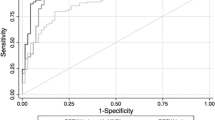Abstract
When compared to patients with erosiveesophagitis, patients with Barrett's esophagus havedemonstrated reduced chemo- and mechanoreceptorsensitivity to acid infusion and balloon distension,respectively. However, anecdotal clinical experiencesuggested an increase in symptom perception in patientsafter successful elimination of Barrett's epithelium,using multipolar electrocoagulation (MPEC) and high-dose proton pump inhibitor (PPI). To determineperception thresholds to acid infusion, we evaluatedeight consecutive patients after a series of MPECtreatments resulted in complete elimination of Barrett's mucosa and compared them to 10 age-matchedpatients with nonreversed Barrett's esophagus and 10patients with symptomatic, endoscopy-documented erosiveesophagitis (Hetzel-Dent grade 2 or greater).Chemosensitivity was determined by a modified acid perfusiontest, where acid perception thresholds were quantifiedby the lag time to initial typical symptom perception,sensory intensity rating, and an acid perfusion sensory score (APSS). While patients aftersuccessful elimination of Barrett's esophagus hadsimilar sensory intensity ratings and APSS as patientswith erosive esophagitis, the lag times differedsignificantly between the groups, and both groups hadsignificantly higher sensory intensity ratings and APSSthan patients with nonreversed Barrett's esophagus. Inconclusion, patients after complete reversal ofBarrett's mucosa are unexpectedly as sensitive to acid assymptomatic patients with erosive esophagitis.
Similar content being viewed by others
REFERENCES
Spechler SJ, Zeroogian JM, Antonioli DA, Wang HH, et al: Prevalence of metaplasia at the gastro-oesophageal junction. Lancet 344:1533–1536, 1994
Pera M, Cameron AJ, Trastek VJ, Carpenter HA, et al: Increasing incidence of adenocarcinoma of the esophagus and esophagogastric junction. Gastroenterology 104:510–513, 1993
Gore S, Healey CJ, Sutton R, Eyre-Brook IA, et al: Regression of columnar lined (Barrett's) oesophagus with continuous omeprazole therapy. Aliment Pharmacol Ther 7:632–638, 1993
McArdle JE, Lewin KJ, Randall G, Weinstein W: Distribution of dysplasias and early invasive carcinoma in Barrett's esophagus. Hum Pathol 23:479–482, 1992
Gossner L, Sroka R, Stolte M, Seitz G, et al: Barrett's esophagus with severe dysplasia and/or superficial cancer: Initial results of photodynamic therapy using 5-aminolaevolinic acid. Gastrointest Oncol 110:A521, 1996
Sampliner RE, Hixson LJ, Fennerty MB, Garewal HS: Regression of Barrett's esophagus by laser ablation in an antacid environment. Dig Dis Sci 38:365–368, 1993
Berenson MM, Johnson TD, Markowitz NR, et al: Restoration of squamous mucosa after ablation of Barrett's esophagus epithelium. Gastroenterology 104:1686–1691, 1993
Jones R, Barnham CP, Hardwick R, Shepherd N, et al: Regression of columnar-lined esophagus following KTP laser ablation with acid suppression. Gastroenterology 110:A537, 1996
Laukka MA, Wang KK: Initial results using low dose photodynamic therapy in the treatment of Barrett's esophagus. Gastrointest Endosc 42:59–63, 1994
Wang KK, Geller A, Gutta K, Laukka M, et al: Photodynamic therapy in the treatment of Barrett's esophagus. Gastroenterology 110:A290, 1996
Overholt B, Panjehpour M, Tefftellar E, Rose M: Photodynamic therapy for treatment of early adenocarcinoma in Barrett's esophagus. Gastrointest Endosc 39:73–76, 1993
Overholt BF, Panhehpour M: Barrett's esophagus: Photodynamic therapy for ablation of dysplasia, reduction of specialized mucosa, and treatment of superficial esophageal cancer. Gastrointest Endosc 42:64–70, 1995
Overholt BF, Pannehpour M: Photodynamic therapy for Barrett's esophagus: Clinical update. Am J Gastroenterol 91:1719–1723, 1996
Barr H, Shepherd NA, Roberts DJH, Tan WC, et al: Eradication of high grade dysplasia in columnar lined (Barrett's) oesophagus by photodynamic therapy with endogenously generated protoporphyrin IX. Lancet 348:584–585, 1996
Sampliner RE, Fennerty MB, Garewal HS: Reversal of Barrett's esophagus with acid suppression and multipolar electrocoagulation: Preliminary results. Gastrointest Endosc 44:523–525, 1996
Aronchick CA, Lipshutz WH, Wright SH, DuFrayne FJ, et al: P9 bicap cautery converts Barrett's epithelium to squamous mucosa. Am J Gastroenterol 90:A1554(3), 1995
Schlesinger PK: Diminished esophageal acid sensitivity in patients with advanced esophagitis. Gastroenterology 92:A1622, 1987
Johnson DA, Winters C, Spurling TJ, et al: Esophageal acid sensitivity in Barrett's esophagus. J Clin Gastroenterol 9:23–27, 1987
Trimble KC, Pryde A, Heading RC: Lowered esophageal sensory threshold in patients with symptomatic but not excess gastroesophageal reflux disease: Evidence for a spectrum of visceral sensitivity in GORD. Gut 37:7–12, 1995
Stein HJ, Hoeft S, DeMeester TR: Functional foregut abnormalities in Barrett's esophagus. J Thorac Cardiovasc Surg 105:107–111, 1993
Johnson LF, DeMeester TR: Twenty-four hour pH monitoring of the distal esophagus. Am J Gastroenterol 62:325–332, 1974
Hetzel DJ, Dent J, Reed WD, Marieluala FM, et al: Healing and relapse of severe peptic esophagitis after treatment with omeprazole. Gastroenterology 95:903–912, 1988
Gracely RH, McGrath P, Dunber R: Ratio scales of sensory and affective verbal pain descriptors. Pain 5:5–18, 1978
Smith JL, Opekun AR, Larkai E, Graham DY: Sensitivity of the esophageal mucosa to pH in gastroesophageal reflux disease. Gastroenterology 96:683–689, 1989
Fass R, Higa L, Kodner A, Naliboff B, et al: Chronic mucosal inflammation of the esophagus in gastroesophageal reflux disease (GERD) is not associated with mechanical hyperalgesia. Gastroenterology 110:A662, 1996
Sampliner RE: Ablative therapies for the columnar lined esophagus. Gastroenterol Clin North Am 1997 (in press)
Mayer EA, Gebhart GF: Basic and clinical aspects of visceral hyperalgesia. Gastroenterology 107:271–293, 1994
Campbell JN, Raja SN, Cohen RH, Manning DC, et al: Peripheral neural mechanisms of nociception. In Textbook of Pain. RD Wall, R Melzack (eds). New York, Churchill Livingstone, 1989, pp 22–45
Rights and permissions
About this article
Cite this article
Fass, R., Yalam, J.M., Camargo, L. et al. Increased Esophageal Chemoreceptor Sensitivity to Acid in Patients After Successful Reversal of Barrett's Esophagus. Dig Dis Sci 42, 1853–1858 (1997). https://doi.org/10.1023/A:1018850824287
Issue Date:
DOI: https://doi.org/10.1023/A:1018850824287




